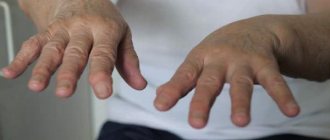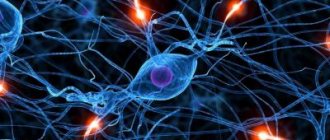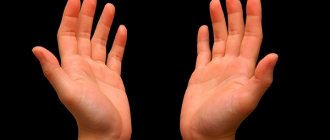Sudden and uncontrollable nighttime cramps in one or both legs in a child are a very unpleasant and painful phenomenon that frightens not only children, but also parents.
What are the causes of night cramps? Is nighttime muscle contraction dangerous for a child’s health, or will it pass without a trace?
How to relieve sudden muscle soreness? What is first aid?
In a baby
Signs
During nervous overstrain or REM sleep, the newborn shakes in one or more parts of the body:
- legs;
- chin (why does a child’s chin shake);
- pens;
- sometimes – neck muscles.
Physiological tremor in infants is considered when the child’s age does not exceed 3 months and the problem arose immediately after a stressful situation (changing clothes, fear, dissatisfaction, crying). Moreover, physiological tremor in newborns is most pronounced; parents are very worried about the condition of the baby. Sometimes head shaking occurs during feeding.
These types of tremors in infants rarely persist beyond the age of 3 months, but sometimes children under one year old experience it. It is not uncommon for a baby to develop physiological tremor even at 9 months of age.
It is worth noting that, compared with pathological tremor, with physiological tremor in newborns the limbs twitch with less frequency, duration and amplitude
When parents carefully observe their baby, they immediately understand why their baby is experiencing episodes of physiological tremors. The most critical period for a baby is considered to be between 1 and 3 months.
After a year, there should be no tremor of the head and limbs, otherwise the disease is pathological, acquired either in the mother’s womb or during childbirth. This type of tremor in children lasts up to any age, sometimes even adolescence, leads to twitching of the head, chin or limbs and other symptoms:
- sleep disturbance;
- nervousness;
- I cry often.
Important! If a child experiences frequent head twitching (especially after sleep), this indicates high intracranial pressure, perinatal encephalopathy, hyperglycemia and other diseases that are no less dangerous for him. A timely visit to a pediatric neurologist will eliminate tremor in newborns as soon as possible.
Causes
Why do young children experience this condition? It's all about the incorrect development of the centers of nerve endings. And since these centers are located in the brain, head shaking is not uncommon. When a baby experiences stress, the level of norepinephrine in his blood increases, after which severe muscle tension and twitching of the limbs occur.
The following reasons usually contribute to tremor:
- Fetal hypoxia. When the umbilical cord is entangled or due to any other cause of hypoxia, the newborn experiences severe stress.
- Risk of miscarriage . With hormonal imbalances or diseases of the genital organs, uterine hypertonicity appears. This functioning of a pregnant woman’s body greatly affects the fetus; the baby shakes its arms and legs even after the first year of life.
- Infections suffered by a pregnant woman. Pregnancy needs to be planned. Before it, diagnosis and treatment of infectious diseases is required. Otherwise, after passing through the birth canal, the baby is born with serious diseases.
- Placental abruption. If this happens before birth, the risk of losing the child greatly increases. Urgent treatment for a pregnant woman consists of rapid delivery and prevention of inflammation, shock and blood loss.
- Prematurity. Children born between 28 and 37 weeks, weighing no more than 2500 kg and up to 45 cm tall, are considered premature. Some parents believe that such children are incapable of further development. However, it is not. They are very weak, their psychomotor and speech development is slower. But they catch up with the development of their peers at the age of 2 - 3 years, with stage 3-4 prematurity - at 5 - 6 years.
- Birth injury . The main reasons are mechanical and hypoxic, when due to too long labor there is constant pressure on the fetus.
- Severe pregnancy stress. It is known that increased norepinephrine affects not only the pregnant woman, but also the unborn child in the stomach. Even a systematic lack of sleep can cause tremors in a baby. Therefore, to prevent these reasons from arising, a woman should not experience constant stress and lack of sleep.
Treatment
Having determined the cause of trembling of the child’s limbs, the neurologist prescribes individual treatment. Most often, it does not involve drug therapy, but includes physical therapy, massage, and may prescribe light electrophoresis of 7 to 10 sessions. After such a comprehensive treatment, the baby’s arms, legs, and chin shake less, he sleeps more soundly and feels better in the morning.
Neurologists also allow:
- massage the area of the legs and arms;
- do gymnastics;
- take baths with lavender, chamomile or other calming plants, provided that the baby does not have allergies;
- take air baths.
Physiological tremor therapy is not prescribed for children under one year of age.
If the tremor experienced by newborns is pathological, the environment in the home should be kept as calm as possible. The more tense the atmosphere, the longer the treatment will be.
In children older than one year
Signs
Involuntary shuddering of a hand or other part of the body also occurs in children over 1 year of age. Sometimes they feel as if a certain part of the body is not moving smoothly, but jumping. This condition is associated with muscle hypertonicity. With a pronounced emotional outburst, the child experiences twitching in the area:
- chin;
- sometimes the muscles of the neck, tongue, trunk or facial muscles are involved.
Sometimes the child’s hands or other limbs shake even at rest. It has been noticed that a baby who prefers to fall asleep on his stomach trembles less than a baby who sleeps on his side or back. In addition to muscle tremors, the child may experience:
- headache;
- insomnia;
- irritation.
It is worth noting that in children at any age, tremor can progress if timely treatment is not prescribed. First, one limb is involved in the process, then the second, then other muscle groups.
Among all types of tremor, the safest is considered to be benign, in which only one limb trembles. It’s more difficult when the child’s arms or legs shake. The most severe is Asterixis: the child performs very slow and uncertain movements and experiences liver or kidney failure.
Trembling of the hands or other parts of the body in children older than one and a half years appears only due to pathology, infectious diseases of the woman’s genital organs, unsuccessful pregnancy or difficult childbirth. Therefore, it is necessary to treat this condition.
How are they treated?
Even if the disease is determined only by hand tremors, complex therapy is required. The child is prescribed:
- electrophoresis sessions with the possible use of "Eufillin" and Mg 2%;
- walks in the open air;
- balanced diet;
- gymnastics;
- massage.
In some cases, beta blockers are required. If the cerebellum has been damaged, surgical treatment is prescribed. The neurologist recommends monitoring the dynamics of therapy using ultrasound or an electroencephalogram of the brain. Upon completion of treatment, consultation with a pediatric neurologist about tremor prevention is necessary.
Thus, if a child detects trembling of the head or limbs, attentive parents urgently show it to a qualified pediatric neurologist. If you follow all the doctor’s recommendations, the most positive prognosis will be achieved.
Consequences
The child experiences the very first consequences of tremor in infancy - nervousness and frequent crying. Sleep is gradually disturbed, and the range of movements increases. Trembling begins to appear for absolutely no reason.
Tremor itself has no effect on life expectancy. But pathology in a child over a year old and in an adult always signals a neurological disease, a disorder of the cerebellum or an accumulation of copper in the blood, liver or membranes of the brain.
The danger of the disease lies in the gradual loss of ability to work. This is especially true for people who do not treat the tremor at the same time as its cause. Parkinson's disease (which mostly occurs in older people) also develops slowly.
With the birth of a baby, most mothers have questions about why the baby starts to flinch during sleep. Especially in the first months of birth, almost all babies shudder. Most likely, this is due to the restructuring of the body. After all, at birth a child finds himself in a completely different world.
Previously, he felt calm, his mother’s heart beat evenly, but now everything is different. When he sleeps, he feels insecurity, the absence of a loved one and the conditions to which he is accustomed. He also senses the presence of many unusual and unfamiliar sounds and smells.
Transition between sleep stages
Most often, a child's twitching occurs at the moment of falling asleep. This phenomenon also occurs in adults, and is easily explained from a medical point of view.
Human sleep is periodic, consisting of slow and deep phases, while the cycle that replaces them lasts only 50 minutes in a month-old baby. When falling asleep, an adult goes into deep sleep almost immediately, while a baby sleeps lightly for the first 20-30 minutes.
Thematic material:
When the phases change, the so-called shudder occurs. An adult at this moment may dream that he is falling into an abyss or flying quickly. A muscle spasm that causes the body to twitch is a defensive reaction to the body slowing down its processes.
In medicine, this is called hypnagogic fear. Both the adult and the child sometimes wake up at this moment.
The importance of your baby's restful sleep
In infancy, children sleep for a long time, especially up to 3 months. Their sleep can last up to 18 hours a day. This is considered normal; at this time, the formation of the nervous system occurs. In sleep, a child develops and grows better. After waking up, he behaves more calmly and is not capricious.
An infant has polyphasic sleep. In REM sleep, babies dream, but in deep sleep, they do not. The baby should sleep calmly and soundly, always during the day, only then will he be able to develop correctly and normally.
To do this you need:
- be in the fresh air;
- feed properly;
- keep the room temperature no higher than 22 °C;
- be active during the daytime;
- limit emotional stress;
- bathe the baby before bedtime in water with decoctions of medicinal herbs with a sedative effect.
Newborn sleep patterns and duration
Adult sleep is different from how a newborn baby should sleep. The baby's sleep duration is divided into phases of approximately 1 hour 20 minutes - 1 hour 40 minutes. The first 15-20 minutes are superficial sleep. You may notice that the baby is twitching, muscles are tense, eyes are slightly open, breathing is frequent and uneven, and sometimes he may “hum” something.
If you are holding a baby in your arms, after 20 minutes of such dozing, you will notice that the baby is limp, relaxed, breathing has leveled out - the deep sleep phase has begun. Experienced mothers know that now, even if the baby twitches, he will not wake up from your movement, and he can be safely transferred to the crib.
The phase of sound sleep in babies up to 2-3 months lasts no more than an hour and a half and is soon replaced by shallow sleep, and the child can wake himself up. This is a kind of protective mechanism of the child’s body, which allows it to control the still unsettled respiratory system.
But such a change of phases does not mean that the newborn wakes up every hour and a half. If he is comfortable, he is fed, dry, his mother is nearby - even the smallest baby is able to sleep for 8-10 hours in a row without waking up.
Causes
Many reasons have been identified why a baby shudders when he sleeps. Some of them should not particularly worry parents, since they are observed in all infants.
Flatulence
A recently born child is faced with the fact that the muscles of his intestines are underdeveloped, and therefore do not push through incoming food well. During feeding, the baby swallows air along with milk. It begins to put pressure on the intestinal walls and cause pain. The baby pulls up his legs, stretches out, twitches.
Over time, everything should return to normal. The body will adapt to new conditions. The shaking and colic when the baby sleeps will stop.
State of fatigue
Many parents wonder how a child can get tired if he most often lies or sleeps? But we must not forget that with birth the baby learns everything new that surrounds him. He examines everyone, listens to the sound of voices and various sounds. And his relatives come up, try to talk to him, rattle him with a rattle.
With increased activity, the child becomes excited, so he falls asleep poorly and will startle more often in his sleep. To eliminate this, you need to talk calmly to the baby, and find quieter places on the street where there are no sharp sounds that frighten the baby.
Dreams I had
A child who receives many different impressions during the day, when he sleeps, dreams. Deep sleep is very short. Therefore, alternation and transition from one phase of sleep to another can cause the child’s body to flinch.
And also such dreams, when the baby feels some kind of failure, cause hypnagogic fear. At this time, you may notice that the baby is twitching.
Teething
At about 6 months, the baby's first teeth begin to erupt. Babies may experience anxiety, pain, and may startle in their sleep.
Defecation and urination
While children are still very small, they go to the toilet directly in the diaper. At this time, they have to push, jerk their legs, and parents notice movements and shuddering.
Noises
Many children react to the presence of sharp and sudden sounds by flinching. This could be a noise coming from the street or something falling in the apartment. They get used to ordinary sounds, but not to sharp and new ones.
Hand movements
Newborns are especially afraid of moving their own hands. This happens because they begin to twitch during sleep. It is better to swaddle your hands at first.
What to do to protect your baby from flinching
When parents observe that their child shudders in his sleep, there is no need to immediately worry or worry about why this is happening. It is enough to gently stroke him, pick him up when he cries, rock him and talk to him in a gentle voice. You can change the child's position. Sometimes it is enough to put him on his tummy, then he will be less afraid of his hands.
At first, it is better to swaddle a newborn; he feels more protected and is not afraid of hands.
Some parents purchase the Vitafon device. It phonates the intestines and gradually strengthens its muscles. There is less gas, and the child sleeps more peacefully.
Reasons to contact a pediatrician
Most often, flinching is safe for the child. It grows and they gradually stop. But there are still reasons that it is advisable to inform your pediatrician about.
Parents should be alert if:
- prolonged shuddering occurs, accompanied by trembling;
- the child often wakes up and cries at night;
- regurgitation occurs like a fountain;
- convulsions are observed.
All this needs to be told to the doctor, since such manifestations can be symptoms of various diseases. In the first year of a child’s life, you need to be especially attentive to him, respond to his movements, including winces, and report everything to your pediatrician.
A twitch is a sudden, involuntary movement that occurs at any time, including when a child is deeply asleep.
Sleepy ritual
A young mother should know that rest for a baby is a very important part of his life. Why? Because during night/day rest the body grows and develops intensively. There is also active formation of cellular structures and brain development. Therefore, proper rest for the baby is very important for him.
Create a sleep ritual and treat it very responsibly! The ritual should take place at the same time in the evening and consist of a certain sequence of actions:
- Creating a sleepy space: turn off the lights, music and family squabbles.
- Ventilation of the room: it is imperative and absolutely necessary to fill the room with fresh oxygen.
- Bathing the baby: you can skip it only if the baby is unwell.
- Light body massage: stroke the body with a warm hand, the little one will soon get used to this procedure and will fall asleep faster.
- Milk feeding: Give your baby breast milk or formula.
- Lullaby song: it sets you up for a happy wave of dreams.
Some babies love to frolic in the bath; for some reason, water has an exciting effect on them. If your baby is the same type, bathe him a couple of hours before bedtime.
The meaning of the ritual is to evoke the right associations in the baby associated with a night's rest. Children quickly get used to what their mother taught them. If the mother teaches him to fall asleep at the breast, the baby will take this as a guide to action. Then don’t be surprised that he demands breasts from you before bed.
Important! The experience of thousands of happy mothers shows that the toddler quickly realizes the connection between bathing/feeding/song and sleep.
How to get rid of stretch marks after childbirth?
Most often, a child's startling occurs at the moment of falling asleep. This phenomenon also occurs in adults, and is easily explained from a medical point of view.
Mothers of babies sleep lightly, waking up from any sound from the crib. They care about everything: how the baby breathes, which side he sleeps on, body temperature. And if a clogged nose is a completely predictable phenomenon, then when a child twitches in a dream, every woman panics. Why do shudders happen, and is it so dangerous?
Baby 3 months old - wakes up and cries
Why does a newborn shake in his sleep?
REM sleep phase
What happens if a newborn baby starts in his sleep? Babies dream just like adults, which means they also experience REM, or rapid eye movement, sleep during their dream cycle. During REM sleep, the newborn's face will tremble. He will also likely breathe irregularly, snort, whimper, and flail his arms and legs. Don't worry, REM sleep gets shorter as babies get older.
According to research, the order will change in about 2 to 3 months. As your baby gets older, he will go through other stages of sleep before entering REM sleep. As the child gets older, the amount of REM sleep decreases and sleep becomes restful. By age 3, children spend a third of the night in slow-wave sleep.
The reason for consultation with a specialist is a situation when the baby wakes up more than 10 times and looks scared.
The Moro reflex is another reason why newborns startle in their sleep. Babies are born with a set of reflexes, but this is the most alarming manifestation for new parents. When a baby starts in his sleep or feels like he is falling, he will throw his arms out to the side with a sudden jerk and perhaps scream.
Like many other reflexes, the Moro reflex is a built-in survival mechanism designed to protect a vulnerable newborn. And this is a primitive attempt to restore a noticeable loss of balance. Again, don't worry if you see your baby suddenly startling and throwing up his arms while sleeping.
Pain
With colic or teething, the child twitches in his sleep due to periodic pain.
Noise
This is another factor why a newborn twitches in his sleep. A loud sound can scare and wake up a baby.
But you don’t need to maintain absolute silence for your baby to sleep. There are sounds that are familiar to a baby - rustling sounds, the hum of a washing machine, the quiet voice of mom or dad, the sound of water, and others.
Sometimes there is a sharp sound of a siren or the sound of a falling object coming from the street. Such a noise is unusual and new for the baby, because of this the baby shudders sharply. Even after some time, when the fear seems to be forgotten, the child shudders in his sleep due to excitement of the nervous system.
Temperature
During sleep, the baby twitches and tosses and turns when he feels stuffy. Stuffy or musty air in the bedroom is irritating to the baby and causes discomfort.
Uncomfortable position
It is likely that the baby is not comfortable sleeping in the position in which his parents put him. The baby shudders and begins to spin around in search of a comfortable position.
Feeling insecure
Some pediatric doctors have given the name “4th trimester of pregnancy” to the first three-month stage of a baby’s life and advise recreating conditions for the baby that maximally imitate those in the womb. This will give the baby a feeling of protection and deep sleep.
The sleep jerking described above is normal and does not require treatment.
However, there are times when a child shudders in his sleep due to various diseases.
Treatment
If the condition when a child twitches in his sleep is physiological, that is, not related to a disease of the central nervous system, then treatment is not required. Such symptoms in children develop due to immaturity of the brain. As the baby grows and his nervous system differentiates, twitching during sleep becomes significantly less.
- febrile convulsions - if the cause of febrile convulsions is a high temperature, against the background of a viral infection, then treatment of the underlying disease is carried out, aimed at reducing the temperature. As a rule, febrile seizures in children develop due to rapidly rising temperature.
Therefore, to prevent this pathological condition, the baby’s parents need to monitor the fever and prevent it from rising to high numbers. Drug treatment for a viral infection is prescribed by a pediatrician. As a rule, with age, febrile seizures pass without affecting the physical and psycho-emotional development of the child.
The life prognosis for spasmophilia is positive. As a rule, no residual effects are observed with this disease.
- convulsions observed with organic brain lesions, due to birth injuries or asphyxia, require specific anticonvulsant therapy prescribed by a neurologist. Depending on the degree of damage to the central nervous system, this therapy is supplemented with medications that reduce brain swelling and stimulate the development of the baby’s mental activity.
Along with drug therapy, general massage, baths with pine concentrate, and a decoction of chamomile and mint flowers are carried out. For older children, electrophoresis with bromine is prescribed to the collar area.
The prognosis for children with various diseases, both organic in nature, will be positive in terms of physical and mental development, since the child’s body has great plasticity and timely treatment gives a good result.
Only with significant brain damage and developmental delays, children with severe mental disorders will have an unfavorable prognosis for life and social adaptation. In this case, such children are subject to treatment by a psychiatrist.
Does your child twitch in his sleep? Why is this happening, is there a danger? There is no danger in this phenomenon: all children twitch in their sleep. To understand the cause of twitching, you need to understand what phases a person’s sleep consists of.
A baby sleeps in the same way as an adult: he falls asleep and wakes up, closes his eyes and dissolves in the world of dreams. A little person's sleep consists of phases of falling asleep, alternating shallow and deep sleep and waking up. An infant spends most of his day in the dream world.
However, the baby’s rest differs in that the shallow sleep phase takes up most of the time.
. In adults, on the contrary, the deep sleep phase prevails. In the deep phase of dreams, a person sleeps “like a dead man” and does not stir.
In the superficial dreaming phase, body muscles twitch and facial expressions change. This explains the baby’s behavior in his sleep: he constantly twitches and shudders at times.
How long will the baby behave this way in his sleep, until how many years or months? The child will stop twitching only by the age of five.\
Until this time, he needs a short sleep phase for:
- Body growth.
- Proper development.
However, the baby’s anxious rest may not be caused by a physiological feature:
- a child may feel discomfort in an overheated or unventilated room;
- the child spent an emotionally stormy day, his psyche was overexcited;
- the child overate/or underfed before the night's rest.
The mother must distinguish when the baby twitches in the superficial phase of sleep (a physiological process), and when it is due to overexcitation or malnutrition.
Why does the child flinch? Pathological causes
Convulsive rhythmic movements of the baby that continue throughout sleep, combined with screaming and crying, are signs of health problems. Parents who discover these manifestations should take their baby to the doctor as soon as possible.
- Metabolic disorder.
The baby's central nervous system is gradually stabilizing, so it is still difficult for his body to carry out certain metabolic processes.Remember that a possible discrepancy between the amount of food and the child’s physical activity leads to metabolic disorders, which causes a shortage or, conversely, an excess of certain elements. All this leads to diseases, the symptoms of which are muscle spasms. It could be anemia.
- Lack of calcium.
When a baby does not eat properly and the body lacks calcium and vitamin D, rickets develops, a disease that causes changes in skeletal structures. Externally, the body seems to be distorted. Problems with the functioning of the nervous system may occur. - High intracranial pressure.
Sleep disorder is one of the symptoms of increased... This pathology can occur as a result of trauma at birth. Brain cancer may also be the cause. - Syndrome of increased neuro-reflex excitability (HRNRS)
is the result of a disruption of the central nervous system. For this reason, the infant often shudders. This diagnosis is most often made to children with birth trauma.
If the disease is not detected in a timely manner, this will lead to inattention, restlessness, and sloppiness in the child in the future. Memory lapses are also possible.
Recommendations for arranging restful sleep for a newborn
- Ventilate the bedroom every day before putting your baby to bed;
- even in severe frost in the nursery, open the window for 5 - 10 minutes;
- Install a thermometer in the bedroom and monitor the temperature. It should not exceed 18-21° C;
- do not wrap the baby up. Dress your child in high-quality, warm pajamas made from natural fabric, rather than covering him with several blankets;
- the crib must be placed as far as possible from the radiator and heaters;
- experiment by placing the baby on its side or back to choose the most comfortable position;
- Change the baby's sleeping position every three hours if he has not done this himself. For example, turn your head in the other direction;
- remove everything unnecessary from the bed;
- dose activity while awake. 1.5 - 2 hours before going to bed, proceed to quiet activities;
- Give your baby a relaxing bath before bed;
- give a soft massage. This will help the child relax;
- In the children's bedroom, when going to bed, eliminate extraneous movements and loud conversations. A quiet environment will help the baby fall asleep faster;
- swaddling your baby at night will recreate his intrauterine sensations;
- You can use a special zippered cover. In it, the baby will not twitch his arms and will not frighten himself.
Weak and short-term twitching at night is not dangerous; this is considered normal behavior for infants. Experts argue that the baby’s brain structures are still immature and excitation mechanisms predominate over inhibitory reactions. Therefore, parents should not panic. They need to provide the most comfortable conditions for the baby to sleep soundly.
If the baby’s sleep anxiety persists even after providing comfortable conditions - the child sleeps poorly and constantly wakes up, you should consult a doctor. If there is a disease, the necessary measures will be prescribed.
Thus, infants may have prolonged dreams and exhibit bizarre reflexes during sleep. Babies make a lot of strange noises while they sleep. They will gurgle, pant rapidly, stop breathing for as long as 10 seconds, whimper, scream, whistle, and make rattling noises if their nose is blocked. This is completely normal.
Parents often notice that the baby can often shudder, and a similar phenomenon occurs both in reality and in a dream. Bearing in mind the various stories voiced in almost every program about children's health on TV about increased tone of the nervous system and the Syndrome of Increased Nervous-Reflex Excitability, leading to other unpleasant consequences, many parents begin to seriously fear for the health of their baby.
And the more often this happens, the more worried the parents are and the more tense the atmosphere around the child becomes. This, in turn, does not make his life more comfortable, because the baby is sensitive to the mood of his parents.
But in most cases, tremors are not caused by harbingers of a terrible disease or abnormalities in the central nervous system. Most often, the fact that a 7-month-old child shudders is simply explained by not yet fully formed responses to stimuli. In this case, irritants can be both external (the sound of the refrigerator turning on, a knock in the next room, a fly landing on your face) and internal (the intestines began to growl, etc.). The child does not even realize that he shuddered.
Increased tone of the nervous system also occurs, but in children under one year of age this is a normal physiological phenomenon. Over time, these flinches become less frequent. During sleep, startles can occur during the transition from REM to NREM sleep. This is also observed in many adults.
Convulsions should be of greater concern. If a baby’s muscles often begin to rapidly contract, it is necessary to show him to a neurologist, who will determine whether this is a disorder of the nervous system or whether the baby is shuddering due to the same physiological increase in the tone of the nervous system. After which the doctor will prescribe appropriate treatment.
It should also not be confused with an unhealthy manifestation if a baby, frightened by something, begins not only to cry, but also to shake his whole body. Moreover, this can happen without crying. This is a normal manifestation of severe fear in a child. It is advisable to protect the baby from factors that frighten him, which may be certain sounds of household appliances, a photo flash, a scary toy and others.
In case of any overexcitation, you should not give your child any medications as a sedative. It is best to rinse it daily with water with the addition of mint and chamomile infusion.
Young mothers after childbirth are faced with many strange phenomena in their baby. The most common of these is starting in sleep. When a calmly sleeping child suddenly shakes with tremors, it can be quite frightening. What reasons lead to shudders, and should we be wary of them?
Causes of uncontrollable shuddering during sleep
According to pediatricians, shuddering in babies during sleep in most cases does not mean the presence of abnormalities. On the contrary, for children under six months of age they are even the norm. What are the most common causes of this phenomenon?
- Adaptation. During childbirth, the child experiences enormous stress. And then he finds himself defenseless in an unfamiliar world. Under such conditions, it is natural that a small organism must adapt. The startle reflex or Moro reflex is one of the defensive reactions during this period.
- Colic. The digestive system of an infant does not immediately begin to function as expected. Up to three, and often up to four months, the baby may suffer from colic, from which he shudders and cries in his sleep.
- Teething. At an older age, starting from four months, the baby begins to worry about teething. They irritate the delicate mucous tissue of the gums with sharp edges and interfere with restful sleep.
- Active phase of sleep. Newborns, unlike adults, have only two phases of sleep - calm and active. Moreover, the latter predominates in duration. It is not surprising that infant sleep is so sensitive that the baby wakes up from any noise. During the shallow phase, shudders are possible, which means that the child has received too many emotions and is overexcited. Therefore, in the evening it is not advisable to load it with large amounts of information, but rather play calm games.
Startle when falling asleep in adults: causes of nocturnal myoclonus
Complaints of shuddering when falling asleep can be heard quite often. Some people simply state this fact with interest. Others say their cramps during sleep are so intense that they prevent them from getting a good night's sleep. What is the reason for this phenomenon and could it indicate some kind of disturbance in the functioning of the body?
What is nocturnal myoclonus
Slight involuntary twitching of different parts of the body during sleep or when falling asleep is called nocturnal myoclonus by scientists. Before dealing with this phenomenon, it is worth dwelling on the physiology of sleep.
The process of falling asleep is associated with a slowdown in all body functions. The lungs and heart begin to work more slowly and calmly. It is at this time that the brain begins to send signals to the muscles, causing them to contract. This is expressed in slight twitching.
Some scientists consider shuddering while falling asleep to be evidence of increased brain activity. In their opinion, the brain regards slowing breathing and heart rate as a signal of danger. To eliminate a hypothetical threat, he activates his muscles in case he needs to flee.
It should be noted that this is one of the hypotheses for the origin of myoclonic spasms when falling asleep. Another group of scientists explains the phenomenon of myoclonus by the fact that when sleep phases change, the brain produces wave bursts, which lead to involuntary muscle contractions.
Neurologists say that nocturnal myoclonus is the result of an overloaded nervous system. The negative energy accumulated during the day - stress - is, as it were, “processed” by the brain. As a result, when falling asleep, cramps occur in the legs, arms, and other parts of the body. These convulsive movements lead to relaxation of the muscles and the entire nervous system.
Features of night cramps
Myoclonus is an unusual physiological phenomenon. On the one hand, it is studied comprehensively. On the other hand, little is known about him. Scientists have found that there are 2 types of limb twitching when falling asleep: positive and negative myoclonus.
Experts call “positive myoclonus” the active contraction of muscles. This is when, when falling asleep or directly during sleep, a person’s arms and legs twitch, and their eyelids tremble. Cramps when falling asleep can be expressed in twitching of the whole body. It is usually the most intense and often provokes awakening.
Negative myoclonus, on the contrary, is a complete relaxation of nerve endings and a decrease in muscle tone. The syndrome can spread to one area (for example, legs) or the entire body. In the second case, convulsive twitching is observed.
Muscle twitching during the process of falling asleep occurs in both children and adults. The movements can be:
- synchronous and asynchronous;
- rhythmic/arrhythmic;
- spontaneous;
- reflexive.
Most often, the limbs, shoulders, and facial facial muscles shudder. Physiologists explain the process of formation of these convulsions by the fact that a certain group of nerve fibers going to the muscles is suddenly simultaneously excited. Tension occurs, causing the leg, face, or entire body to twitch during sleep.
Pathology or normal?
Myoclonus is characteristic not only of humans, but of almost all living beings. Light tremors in the body in the form of rare single or group movements while falling asleep are considered normal. Doctors agree that this is still a physiologically determined and absolutely normal functioning of the nervous system.
The pathology is considered to be involuntary tremors that occur with varying frequency and frequency throughout the night's sleep. On the one hand, they themselves lead to sleep disturbances.
A constantly startling person wakes up periodically and, as a result, cannot get a good night's sleep. His sleep phases may also be disrupted.
On the other hand, myoclonic convulsions that do not stop after falling asleep may indicate disturbances in the functioning of the body.
Doctors identify the following features of cramps when falling asleep:
- They are never tied to a specific part of the body, so it is impossible to predict the appearance of twitching.
- In some cases, convulsions are pronounced in nature and are felt as a large single shudder. In others, they may have the character of a small trembling of the whole body when falling asleep (tremors).
- Doctors also consider the feeling of falling when falling asleep to be a type of myoclonic spasms.
- Myoclonus usually occurs during REM sleep. That is why it leads to awakening.
- Obsessive, recurring convulsions from night to night often accompany diseases of the nervous system (panic disorders, phobias, depression).
Causes of myoclonus in adults
Doctors see the main causes of pathological shudders when falling asleep and during sleep itself in adults in such conditions as:
- renal failure;
- iron deficiency;
- joint diseases;
- uremia;
- heart diseases;
- diabetes;
- thyroid diseases;
- spinal or head injuries;
- blood flow disorders;
- Parkinson's disease.
Why do my legs twitch?
The legs are more susceptible to myoclonus than other parts of the body. Many people could observe how the leg twitches involuntarily when falling asleep. The main reasons for this phenomenon have already been described. It should be emphasized that leg twitching during sleep in the case of the listed diseases is the least of the evils.
If a person constantly notices that his legs twitch when falling asleep, he should definitely contact a therapist first and tell him about this symptom. The doctor will probably refer you for examination. Do not be surprised if some serious metabolic disorder or even a disease from the above list is discovered as a result.
Many people with depression and sleep disorders describe their nighttime experiences as “restless legs” (also known as Ekbom Syndrome). All these disorders must be treated. Then the unpleasant sensations associated with falling asleep will gradually pass.
Pregnant women often notice how their legs twitch while falling asleep. This is usually associated with a deficiency of iron, potassium, and some other microelements.
What to do in such a situation? First of all, consult your doctor. You may need to adjust the menu or take an additional vitamin complex. After the birth of the baby, the described unpleasant sensations will go away on their own.
Leg twitching during sleep is common in older people. This is due to changes in the functioning of the nervous system. Myoclonus cannot be neglected in this case. It is imperative to conduct an examination to exclude the possibility of serious diseases (for example, Parkinson's disease).
Pathological myoclonus
One of the features of pathological myoclonus is that a person experiences convulsions not only when falling asleep, but also during the day, while awake. This condition is most common in epilepsy. When falling asleep, the patient may twitch different parts of the body. One night the limbs are active, the other night the facial muscles are active.
The causes of seizures when falling asleep in adults in this case may lie in the area of abnormal brain activity. Some patients experience a lack of oxygen in the brain tissue, while in others changes occur at the cellular level.
In some cases, pathological myoclonus is provoked by hereditary diseases. Trembling of the limbs or facial muscles can be observed in children when falling asleep at a very early age. This is possible in the following neurological conditions:
- hereditary pathology of the cerebellum and other parts of the brain;
- epilepsy;
- disturbances in the functioning of nerve endings in the case of diseases of internal organs (liver, lungs);
- so-called “storage diseases” (they are characterized by epileptic seizures, pathological daytime myoclonus, and other less noticeable manifestations);
- viral encephalitis;
- intoxication due to drug overdose.
Twitching during sleep in children
Myoclonic convulsions in a child during sleep are divided into physiological (normal) and pathological. The reason for shuddering when falling asleep in infants is the adequate functioning and development of the brain.
The fact is that the sleep of young children is significantly different from that of an adult. Their deep sleep phase is 2 times shorter than that of a normally functioning, healthy adult. The baby twitches when falling asleep and later almost constantly due to the fact that his sleep phases change faster and his brain activity changes all the time.
Parents should not worry if their child shudders when falling asleep. This is a natural process. But if some other pathological phenomena are added to these movements (for example, cramps during the day), the baby must be examined.
Is treatment necessary?
If we are talking about rare shudders of the torso or limbs when falling asleep, then in most cases no treatment is required. To normalize sleep and prevent excessive muscle activity, you can do the following:
- You must always go to bed and get up at the same time;
- fall asleep no later than 22:00;
- do not drink stimulating drinks (coffee, energy drinks, alcohol) at night;
- if you have severe problems falling asleep, you can use mild herbal sleeping pills (for example, Novo-Passit);
- A warm bath before bed is very relaxing and stimulates blood circulation;
- Eating dairy products, vegetables, and herbs (especially parsley and dill) will help replenish your supply of microelements;
- in case of severe myoclonus, strong tonic drinks (tea, coffee) must be replaced with berries, fruit compotes, herbal teas;
- Regular physical activity helps fight cramps;
- in some cases, to prevent myoclonus, you can take a course of sedatives.
https://www..com/watch?v=kj_bCsb7k8w
Before buying any medications, you should definitely check with a doctor! This will help to promptly identify diseases of the brain and other systems. Only after a complete examination and exclusion of serious pathologies will the doctor be able to prescribe suitable sedatives.
Treatment of pathological myoclonus is carried out only under the guidance of a psychotherapist. In some cases - a psychiatrist. For therapy, drugs such as Konvulex, Clonazepam, Apilepsin, etc. are used. All of them are prescribed individually and are sold in pharmacies exclusively by prescription.
Source: https://neuromed.online/vzdragivanie-pri-zasypanii/
Signs that should alert you
The above reasons lead to single, sharp startles that do not interrupt the baby's sleep. But if the child’s limbs tremble rhythmically and finely, then this is a serious reason to suspect convulsions.
In this case, a visit to a neurologist is inevitable, because convulsive tremors are one of the first signs of epilepsy or other neurological pathology.
Frequent awakenings, more than 10 times per night, after which the child is overly excited and restless, should also alert you. This behavior is permissible only against the background of an illness accompanied by elevated temperature.
What can convulsive, incessant shuddering indicate?
- Metabolic disorder. Metabolic disorders are common in newborns. This is due to the unstable functioning of the central nervous system, as well as an imbalance between its activity and the amount of food consumed. As a result, the body may have an excess or deficiency of any substances, which leads to the fact that it shudders convulsively in its sleep.
- Rickets. The disease can appear against the background of an unbalanced diet and a lack of vitamin D in the newborn. This is especially true for children born in winter, since they do not receive sufficient sunlight for the vitamin to begin to be produced. With rickets, the bones of the skeleton are bent, and the central nervous system can also be affected, as indicated by convulsions during sleep.
- Increased intracranial pressure. One of the causes of sleep disturbances in newborns is intracranial hypertension. It can be the result of trauma at birth, as well as a brain tumor.
- Central nervous system disorders. Sometimes infants are diagnosed with a syndrome of increased neuro-reflex excitability, which occurs after birth trauma. If not treated in a timely manner, the disease leads to constant overexcitability of the child and even memory loss.
Trembling or convulsions?
It is extremely important to separate these two concepts, since seizures are symptoms of serious diseases and a reason for hospital observation.
If a child twitches rhythmically and continuously in his sleep, and when he is picked up, the phenomenon does not stop, we are talking about the second.
By the way, in ordinary children, without a predisposition to epileptic seizures, seizures rarely occur, mainly during elevated body temperatures.
Why is this dangerous? Reaching critical levels, the temperature in infants can cause brain damage. And convulsions in this case are a precursor to an impending threat.
Monitor body temperature especially carefully in children in the first months of life. The younger the child, the more serious the consequences may be.
How to help your baby stop shaking
Calm, deep sleep is the key to the well-being and development of a newborn. Therefore, parents are obliged to do everything possible to ensure that the baby sleeps all night without waking up. How to do this?
In order for the child to go through the adaptation stage as quickly and painlessly as possible, it is necessary to provide him with comfortable living conditions. Surround him with care, talk to him more often, avoiding raised voices, and don’t forget to hug him. But you should not teach your child to sleep in complete silence, because then he will flinch at the slightest rustle.
- If your baby is bothered by colic, you should place him on his tummy between feedings. After eating, turn it over in a “column” to allow gas to escape. It is also necessary to carry out the feeding process correctly, no matter whether the child is breastfed or bottle-fed.
- In case of painful teething, special pharmaceutical preparations will help relieve itching and irritation from the gums. It is also good to let your baby chew on teethers chilled in the refrigerator, which will ease the pain. But bagels and other food products should not be used for this purpose, since small particles that break off can harm the child.
- In the evening it is better not to play active games. Water procedures should be carried out in not hot water with chamomile or other decoctions of sedative plants. Then stroke the baby’s back and tummy, performing a light massage. And read or sing to him before bed in a calm voice.
- It is necessary to introduce a rule to ventilate the room and ensure that the temperature is not excessively high (more than 21 ° C). Daily wet cleaning of the nursery is important.
If, after eliminating all distractions, your child still starts in his sleep and wakes up, you need to contact your pediatrician for help. Delaying often leads to unpleasant consequences that can be avoided with timely treatment.
Prevention
In childhood and adolescence, metabolic abnormalities from the norm are still a common source of night cramps. It is not dangerous and easy to adjust. To do this, you need to balance your diet and make small adjustments to your child’s lifestyle.
You should pay attention to what your baby drinks. If possible, completely eliminate the consumption of any sugary carbonated drinks and concentrated store-bought juices. Aspartame is used as a sweetener in this liquid (an extremely harmful substance for the child’s body). Long-term use of such a sweetener leads to allergic reactions and seizures.
An excellent solution would be to drink freshly squeezed juices, mineral water containing mineral salts and be sure to drink the daily norm of ordinary clean water. By the way, clean water can be sweetened with natural honey and a small amount of lemon juice.
Balance your child's menu. It is advisable to exclude increased consumption of flour products: muffins, chips, waffles, etc. Diversify the table with all kinds of salads from vegetables and fruits rich in vitamins and microelements (in particular, magnesium and potassium). Use your imagination and prepare jelly or jelly from healthy ingredients, sweetened not with sugar, but with natural honey. Potassium-containing bee products are especially useful: honey, bee pollen, propolis, etc.
Additional measures
To increase and normalize calcium metabolism, vitamin D is introduced into the diet. If a child does not want to eat fish, fish oil in jelly capsules would be an excellent solution. He doesn’t like cottage cheese and dairy products - make yogurt with fresh fruit, and from cottage cheese - curd mass with dried apricots, raisins and banana. Involve your baby in the cooking process, consult with him, explain all the benefits of the prepared dishes.
In winter, when there are not many different fresh fruits, you can purchase a pharmacy multivitamin preparation. Taking into account the age of the child, you can choose the necessary complex with the necessary minerals and vitamins.
Does your child attend a sports club with intense physical activity and get very tired? Full recovery of strength does not occur overnight, and in the morning your baby looks tired, lethargic and not rested? Try to temporarily reduce your child's physical activity and hyperactivity. Instead of playing on the playground, you can go to the zoo or play less active games. Try to interest your child in other hobbies.
Pay due attention to where and how your child sleeps. The bed should be comfortable and suitable for the child's height. Some children get used to falling asleep by curling up. Perhaps they are cold, or something else doesn’t suit them. This question is definitely worth clarifying, because the position of the legs during sleep is a very important point. Make it a rule to do relaxing exercises with your child before bed. Walking barefoot on your toes has a good effect. Then you need to massage his feet and toes with warming movements.











